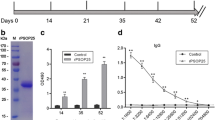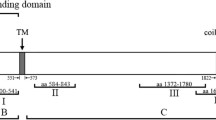Abstract
Microneme proteins (MICs) of Eimeria species are critical for motility of the parasite, identification and binding of host cell-surface proteins, invasion of host cells, and intracellular survival. The microneme protein 1 (EtMIC1) and 2 (EtMIC2) from Eimeria tenella have a putative function in parasite adhesion to the host cell to initiate an invasion process. Previous studies indicated that the EtMIC1 and EtMIC2 proteins form a complex that play roles during attachment to and penetration of the host cell. Numerous studies demonstrated that both the EtMIC1 and EtMIC2 are important microneme proteins which are abundantly expressed in sporozoites and schizogony stages. But the expression of EtMIC1 and EtMIC2 in the gametogony stage is unknown. To investigate the precise roles of EtMIC1 and EtMIC2 in host-parasite interactions and expressions in the gametogony stage of E. tenella, we generated five mouse monoclonal antibodies (MAbs) which recognize the EtMIC1 and EtMIC2 proteins and investigated expressions of EtMIC1 and EtMIC2 proteins in later endogenous developmental stages, particularly focused on the gametogony phase using the specific anti-EtMIC1 and anti-EtMIC2 MAbs produced in this work. Our results showed that both EtMIC1 and EtMIC2 proteins are expressed in all developmental stages including the gametogony stage. To our knowledge, this is the first report that the EtMIC1 and EtMIC2 proteins are expressed in the gametogony stage of E. tenella.






Similar content being viewed by others
References
Allen PC, Fetterer RH (2002) Recent advances in biology and immunobiology of Eimeria species and in diagnosis and control of infection with these coccidian parasites of poultry. Clin Microbiol Rev 15(1):58–65
Belli SI, Ferguson DJ, Katrib M, Slapetova I, Mai K, Slapeta J, Flowers SA, Miska KB, Tomley FM, Shirley MW, Wallach MG, Smith NC (2009) Conservation of proteins involved in oocyst wall formation in Eimeria maxima, Eimeria tenella and Eimeria acervulina. Int J Parasitol 39:1063–1070
Bumstead J, Tomley F (2000) Induction of secretion and surface capping of microneme proteins in Eimeria tenella. Mol Biochem Parasitol 110(2):311–321
Carruthers VB, Tomley FM (2008) Microneme proteins in Apicomplexans. Subcell Biochem 47:33–45
Constantinoiu CC, Molloy JB, Jorgensen WK, Coleman GT (2008) Antibody response against endogenous stages of an attenuated strain of Eimeria tenella. Vet Parasitol 154(3):193–204
Cowper B, Matthews S, Tomley F (2012) The molecular basis for the distinct host and tissue tropisms of coccidian parasites. Mol Biochem Parasitol 186(1):1–10
Dalloul RA, Lillehoj HS (2005) Recent advances in immunomodulation and vaccination strategies against coccidiosis. Avian Dis 49(1):1–8
Dubremetz JF, Garcia-Réguet N, Conseil V, Fourmaux MN (1998) Invited review Apical organelles and host-cell invasion by Apicomplexa. Int J Parasitol 28(7):1007–1013
Ferguson DJP, Brecht S, Soldati D (2000) The microneme protein MIC4, or an MIC4-like protein, is expressed within the macrogamete and associated with oocyst wall formation in Toxoplasma gondii. Int J Parasitol 30(11):1203–1209
Fetterer RH, Barfield RC (2003) Characterization of a developmentally regulated oocyst protein from Eimeria tenella. J Parasitol 89(3):553–564
Hadji-Ghasemi F, Gharagozlou S, Ghods R, Roohi A, Khoshnoodi J, Shokri F (2003) Generation and characterization of a mouse monoclonal antibody with specificity similar to staphylococcal protein A (SPA). Hybrid Hybridomics 22(1):33–39
Huynh MH, Opitz C, Kwok LY, Tomley FM, Carruthers VB, Soldati D (2004) Trans-genera reconstitution and complementation of an adhesion complex in Toxoplasma gondii. Cell Microbiol 6(8):771–782
Kafsack BF, Pena JD, Coppens I, Ravindran S, Boothroyd JC, Carruthers VB (2009) Rapid membrane disruption by a perforin-like protein facilitates parasite exit from host cells. Science 323(5913):530–533
Kawazoe U, Tomley FM, Frazier JA (1992) Fractionation and antigenic characterization of organelles of Eimeria tenella sporozoites. Parasitology 104(01):1–9
Kefu Z, Yingying W, Mei C, Lihong W, Shuichun H, Jun Z, Renhai L, Hong X (2006) Eimeria tenella: further studies on the development of the oocyst. Exp Parasitol 113:174–178
Labbé M, de Venevelles P, Girard-Misguich F, Bourdieu C, Guillaume A, Péry P (2005) Eimeria tenella microneme protein EtMIC3: identification, localisation and role in host cell infection. Mol Biochem Parasitol 140(1):43–53
Lal K, Prieto JH, Bromley E, Sanderson SJ, Yates JR 3rd, Wastling JM, Tomley FM, Sinden RE (2009) Characterisation of Plasmodium invasive organelles; an ookinete microneme proteome. Proteomics 9(5):1142–1151
Lew AE, Anderson GR, Minchin CM, Jeston PJ, Jorgensen WK (2003) Inter- and intra-strain variation and PCR detection of the internal transcribed spacer 1 (ITS-1) sequences of Australian isolates of Eimeria species from chickens. Vet Parasitol 112(1–2):33–50
Liu L, Xu L, Yan F, Yan R, Song X, Li X (2009) Immunoproteomic analysis of the second-generation merozoite proteins of Eimeria tenella. Vet Parasitol 164(2–4):173–182
Morahan BJ, Wang L, Coppel RL (2009) No TRAP, no invasion. Trends Parasitol 25(2):77–84
Paperna I, Smallridge CJ (2001) Ultrastructure of developmental stages of Hemolivia mariae (Apicomplexa: Haemogregarinidae), natural parasite of the Australian sleepy lizard, in experimentally infected deviant hosts. Folia Parasitol (Praha) 48(4):255–262
Ryan R, Shirley M, Tomley F (2000) Mapping and expression of microneme genes in Eimeria tenella. Int J Parasitol 30(14):1493–1499
Sasai K, Fetterer RH, Lillehoj H, Matusra S, Constantinoiu CC, Matsubayashi M, Tani H, Baba E (2008) Characterization of monoclonal antibodies that recognize the Eimeria tenella microneme protein MIC2. J Parasitol 94(6):1432–1434
Sathish K, Sriraman R, Subramanian BM, Rao NH, Kasa B, Donikeni J, Narasu ML, Srinivasan VA (2012) Plant expressed coccidial antigens as potential vaccine candidates in protecting chicken against coccidiosis. Vaccine 30(30):4460–4464
Shi W, Liu Q, Zhang J, Sun J, Jiang X, Geng J, Wang F, Xiao Y, Li H, Zhao X (2014) Co-expression of EtMic2 protein and chicken interleukin-18 for DNA vaccine against chicken coccidiosis. Res Vet Sci. doi:10.1016/j.rvsc.2014.05.001
Shirley MW, Smith AL, Blake DP (2007) Challenges in the successful control of the avian coccidia. Vaccine 25(30):5540–5547
Subramanian BM, Sriraman R, Rao NH, Raghul J, Thiagarajan D, Srinivasan VA (2008) Cloning, expression and evaluation of the efficacy of a recombinant Eimeria tenella sporozoite antigen in birds. Vaccine 26(27–28):3489–3496
Sun H, Wang L, Wang T, Zhang L, Chen P, Chen Z, Wang F, Li H, Xiao Y, Zhao X (2014a) Display of Eimeria tenella EtMic2 protein on the surface of Saccharomyces cerevisiae as a potential oral vaccine against chicken coccidiosis. Vaccine 32(16):1869–1876
Sun H, Wang T, Zhang J, Liu Q, Wang L, Chen P, Wang F, Li H, Xiao Y, Zhao X (2014b) Display of heterologous proteins on the Saccharomyces cerevisiae surface display system using a single constitutive expression vector. Biotech Prog 30(2):443–450
Tomavo S, Slomianny C, Meissner M, Carruthers VB (2013) Protein trafficking through the endosomal system prepares intracellular parasites for a home invasion. PLoS Pathog 9(10):e1003629
Tomley FM, Clarke LE, Kawazoe U, Dijkema R, Kok JJ (1991) Sequence of the gene encoding an immunodominant microneme protein of Eimeria tenella. Mol Biochem Parasitol 49(2):277–288
Tomley FM, Bumstead JM, Billington KJ, Dunn PP (1996) Molecular cloning and characterization of a novel acidic microneme protein (Etmic-2) from the Apicomplexan protozoan parasite, Eimeria tenella. Mol Biochem Parasitol 79(2):195–206
Wallach M (2010) Role of antibody in immunity and control of chicken coccidiosis. Trends Parasitol 26(8):382–387
Wan KL, Chong SP, Ng ST, Shirley MW, Tomley FM, Jangi MS (1999) A survey of genes in Eimeria tenella merozoites by EST sequencing. Int J Parasitol 29(12):1885–1892
Wang T, Sun H, Zhang J, Liu Q, Wang L, Chen P, Wang F, Li H, Xiao Y, Zhao X (2014) The establishment of Saccharomyces boulardii surface display system using a single expression vector. Fungal Genet Biol 64:1–10
Zhang L, Ma L, Liu R, Zhang Y, Zhang S, Hu C, Song M, Cai J, Wang M (2012) Eimeria tenella heat shock protein 70 enhances protection of recombinant microneme protein MIC2 subunit antigen vaccination against E. tenella challenge. Vet Parasitol 188(3–4):239–246
Zhang J, Chen P, Sun H, Liu Q, Wang L, Wang T, Shi W, Li H, Xiao Y, Wang P, Wang F, Zhao X (2014) Pichia pastoris expressed EtMic2 protein as a potential vaccine against chicken coccidiosis. Vet Parasitol. doi:10.1016/j.vetpar.2014.06.029
Zhou BH, Wang HW, Wang XY, Zhang LF, Zhang KY, Xue FQ (2010) Eimeria tenella: effects of diclazuril treatment on microneme genes expression in second-generation merozoites and pathological changes of caeca in parasitized chickens. Exp Parasitol 125(3):264–270
Acknowledgments
This work was supported by the grant from the National Natural Science Foundation of China to XZ (No. 31172314) and the grant from Shandong Province Science and Technology Development Program to XZ (No. 2013GNC11017).
Conflict of interest
The authors declare that they have no conflict of interest.
Author information
Authors and Affiliations
Corresponding authors
Additional information
Qing Liu and Zhengtao Chen contributed equally to this work.
Rights and permissions
About this article
Cite this article
Liu, Q., Chen, Z., Shi, W. et al. Preparation and initial application of monoclonal antibodies that recognize Eimeria tenella microneme proteins 1 and 2. Parasitol Res 113, 4151–4161 (2014). https://doi.org/10.1007/s00436-014-4087-2
Received:
Accepted:
Published:
Issue Date:
DOI: https://doi.org/10.1007/s00436-014-4087-2




